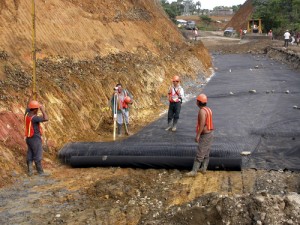While nearly every civilization in history has valued the idea of reinforced soil structures, the method of soil reinforcement in modern construction has only been viable and cost-effective for about 30 years. It took the development of geosynthetics to allow for the substantial tensile loads to stay at their defined formations for an extended period of time.
The use of geosynthetics improves soil’s structural capacity, allows for poorer quality soil to be used, and allows for minimal land acquisition since deformation of soil into steeper slopes is possible.
There are a number of applications where using geotextiles for soil reinforcement make a project easier, more efficient and cost less. Mirafi, the manufacturers of a line of geotextiles, suggested a few of these applications. Here’s why soil reinforcement makes sense in these cases.
- Embankments on weak foundations
Stabilization and reinforcement is often needed on embankments due to the presence of soft foundation soils, low shear strength and excessive consolidation settlements. Through the use of high strength, high modulus geosythetics, these can be offset. This allows for the formation of higher embankments and steeper side slopes, promotes uniform settlements, virtually eliminates excavation and replacement costs and minimizes the time and space required to complete the project.
- Retaining walls
The projects with a need for effective, low cost soil reinforcement retaining walls can be found everywhere. These can not only be achieved through the use of geosynthetics, but they’re also up to 50-percent cheaper than the traditional alternative of cast-in-place concrete walls. Reinforced soil retaining walls allow for the use of on-site fill, and give the contractor a variety of facing options including treated timber, pre-cast concrete panels, natural stone and vegetated facings.
- Subgrade stabilization
In many projects, the load bearing capacity of the soft clays, silts and organic soils that make up the subgrade is necessary. The use of geosynthetics for these projects allows for the uniform distribution of weight. By reducing the amount of required aggregate, this also reduces the total cost of the project by as much as 50-percent. Aggregate thickness and the structural and drainage capacity of the base course is able to be maintained throughout the life of the structure and this enables the project to continue in all weather conditions, which results in faster completion.
- Soft site closures
Particularly at Superfund sites and hazardous waste cells, it’s necessary to cap and close soft sites. This can be safely and cost-effectively through the use of geotextiles with high tensile strength at low elongations to provide durability throughout a process with severe installation stress. Geotextiles eliminate the need for excavation or chemical stabilization and also makes the removal of surface waters easier by filtering or retaining fine sludge particles. Without them, it would be difficult to safely place select fill and there’d be no separation between the select fill and the subgrade.
If you have a project like one of those mentioned here, or one of the many other applications of geotextiles, rely on Maxwell Supply of Tulsa to provide you the materials you need. Call us at 918-836-8606 or browse through our inventory online.
